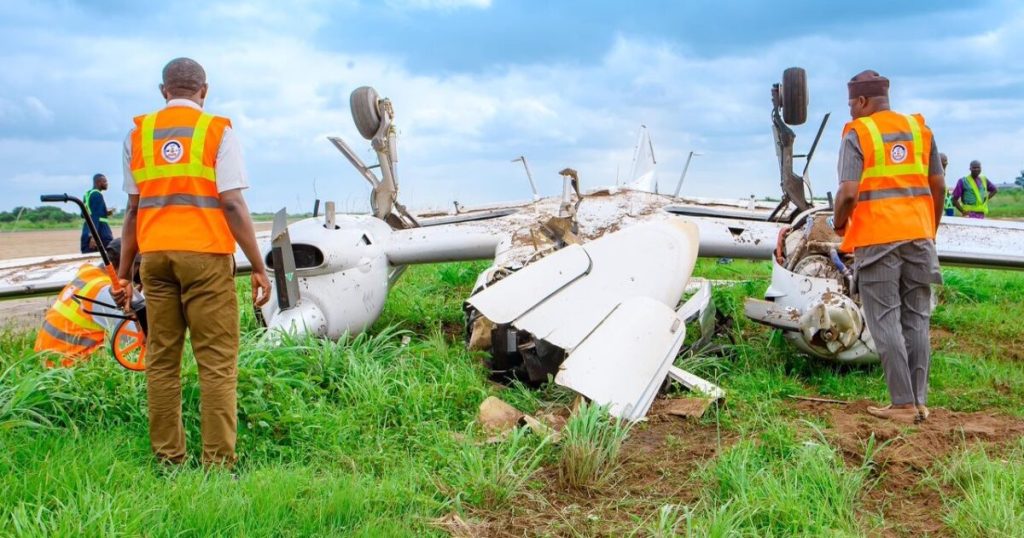Paragraph 1: Incident Overview and Initial Response
On Friday, May 23, 2025, at approximately 17:28 local time, a Diamond training aircraft operated by the Aviation Training School experienced a crash-landing at the General Tunde Idiagbon International Airport in Ilorin, Nigeria. The incident occurred during a simulated instrument approach on Runway 05. Two occupants were aboard the aircraft, both of whom miraculously survived the crash and were promptly transported for medical care. The Nigerian Safety Investigation Bureau (NSIB) was immediately notified and launched an on-site investigation to determine the cause of the accident and prevent similar occurrences in the future.
Paragraph 2: NSIB’s Immediate Actions and Data Retrieval
Following the incident, Captain Alex Badeh, the Director General of the NSIB, personally visited the crash site on Saturday, May 24, 2025, to assess the situation and oversee the initial stages of the investigation. He confirmed that crucial flight data had been recovered, including the aircraft’s data card, a vital piece of equipment that records flight parameters. This data card was transferred to the NSIB’s transport safety laboratory in Abuja for comprehensive analysis. Four specialized investigators remained on-site to complete critical measurements and document the wreckage before returning to Abuja. The recovery operation of the damaged aircraft, which came to rest on the left side of the runway, was nearly complete. The swift response and data retrieval efforts by the NSIB underscored their commitment to a thorough and efficient investigation.
Paragraph 3: Investigation Focus and Preliminary Report Timeline
The NSIB’s primary objective in this investigation is to identify the root cause of the crash, understand the sequence of events leading to the incident, and determine how such accidents can be prevented in the future. This involves analyzing the recovered flight data, examining the wreckage, interviewing witnesses, and reviewing maintenance records, among other investigative procedures. Director General Badeh emphasized the importance of determining the "what," "whom," "how," and "how to prevent" aspects of the accident. The NSIB committed to releasing a preliminary report within 30 days, providing an initial understanding of the incident based on the data gathered in the early stages of the investigation.
Paragraph 4: Condition of the Crew and Public Assurance
Director General Badeh provided an update on the condition of the two occupants of the aircraft, confirming that both individuals had survived the crash and were receiving medical attention. He reported that both occupants were conscious, coherent, and in stable condition. One individual had undergone an MRI scan as part of their medical assessment. The NSIB ensured the public that appropriate medical care was being provided to both crew members. Furthermore, the NSIB reassured the public that the Nigerian airspace remained secure despite the incident, emphasizing the ongoing efforts to maintain safety standards.
Paragraph 5: Detailed Account of the Incident and NSIB’s Methodology
The Diamond training aircraft, operated by the Aviation Training School, was engaged in a simulated instrument approach, a crucial training exercise for pilots to hone their skills in navigating and landing aircraft using instruments in conditions of reduced visibility. The simulation on Runway 05 at the General Tunde Idiagbon International Airport was likely part of a routine training program. The NSIB’s investigation will delve into various factors that could have contributed to the crash-landing, including potential mechanical failures, human error, weather conditions, and any other contributing elements. The detailed analysis of the recovered flight data will play a critical role in understanding the sequence of events leading up to the crash.
Paragraph 6: Significance of the Investigation and Long-Term Impact
The NSIB’s investigation into this crash-landing carries significant importance for the aviation industry in Nigeria. The findings will inform recommendations for improved safety protocols, training procedures, and aircraft maintenance practices. By identifying the root cause and contributing factors, the investigation aims to prevent similar accidents from happening again. The transparency and thoroughness of the investigation process are crucial for maintaining public trust in aviation safety and ensuring the continued development of a robust safety culture within the Nigerian aviation sector. The NSIB’s commitment to releasing regular updates as the investigation progresses further demonstrates their dedication to keeping the public informed and fostering transparency.


